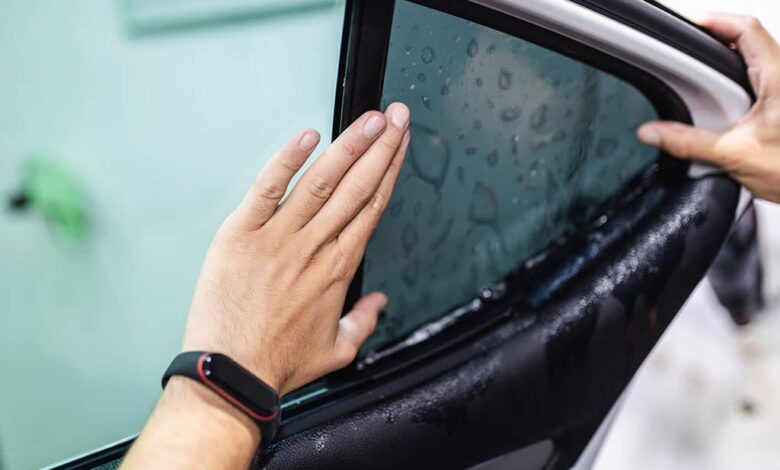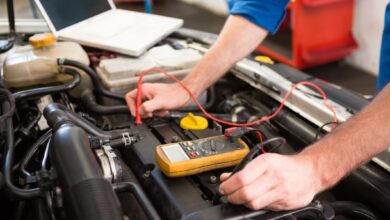
Automotive Window Tinting
Automotive Window Tinting Near Me refers to applying tinted plastic film to the interior glass surfaces of a vehicle. This is done for several key benefits:
- UV protection – Window tint blocks 99% of ultraviolet rays from entering the vehicle. This helps protect passengers from sun damage and skin cancer risks.
- Privacy – Darker tint makes it difficult to see into the vehicle from the outside. This provides security and privacy.
- Glare reduction – Tint reduces glare from sunlight, improving visibility for drivers. This can help prevent eyestrain and headaches.
- Heat reduction – Window film blocks heat from entering the vehicle interior. Tint can reduce interior temps by up to 60%. This keeps passengers cooler.
- Fade prevention – UV rays also cause vehicle interiors to fade over time. Tint protects surfaces like dashboards from sun damage.
- Security – If windows are broken, tint holds glass fragments together, providing added safety.
- Aesthetics – Many drivers tint windows simply because they find the look more stylish and sleek.
So in summary, window tinting offers protection, privacy, comfort, and appearance benefits. It has become an increasingly popular automotive accessory over the years.
Types of Automotive Window Tints
When it comes to automotive window tint, there are four main types to choose from:
Dyed Window Tint
Dyed window tint, also known as dyed film, is the most common and affordable type of automotive window tint. It consists of a thin polyester layer with dye embedded in the film.
Pros:
- Inexpensive
- Good heat rejection
- Wide range of darkness/visibility levels
Cons:
- Can fade, bubble and peel over time
- Doesn’t block as much UV light compared to other films
Metallized Window Tint
Metalized window tint contains microscopically thin metal particles embedded in the film. This gives it a reflective, mirror-like look.
Pros:
- Excellent heat rejection
- High glare reduction
- Long-lasting compared to dyed films
Cons:
- More expensive than dyed films
- Can interfere with radio reception
- Not allowed on front windshield in some states
Ceramic Window Tint
Ceramic window tint contains non-metal ceramic particles that block heat and UV light. It offers the highest heat rejection among automotive window films.
Pros:
- Unparalleled heat rejection
- Excellent UV blocking
- High clarity and minimal visible tint
Cons:
- Most expensive window tint option
- More difficult installation
Carbon Window Tint
Carbon tint contains carbon particles that block UV rays and heat. It provides good heat and glare reduction.
Pros:
- Great UV blocking
- Lower cost than ceramic while still reducing heat
- Fades less than dyed films
Cons:
- Not as effective at rejecting heat as ceramic tint
- Can interfere with radio reception
Window Tinting Laws and Regulations
Laws regarding window tinting vary by state. Most states prohibit excessively dark tint on front windshields and front side windows while allowing darker tint on rear and back side windows. Common restrictions include:
- Front windshield tinting – Most states restrict tint on front windshields to 30% or higher VLT (visible light transmission), allowing only limited UV protection. Some states prohibit any tint on front windshields.
- Front side windows – Restrictions typically range from 35-50% VLT for front side windows next to the driver and front passenger.
- Back side and rear windows – Back side and rear windows often allow tint as dark as 20% VLT or lower.
It’s important to check your state’s specific laws before getting window tint applied. Most tint shops should be knowledgeable on legal limits, but it doesn’t hurt to verify yourself. Going darker than legal limits risks getting a fix-it ticket or citation, and having to remove the excess tint. Fines and penalties vary widely between states and municipalities.
Some states also have restrictions on reflective or metallic tints that affect outward visibility. It’s advisable to avoid these types of tint for front and front side windows.
How to Choose a Reputable Tint Shop
When it comes to tinting your car windows, choosing the right tint shop is crucial for getting professional results. Here are some important factors to consider when selecting an automotive window tinting shop:
Experience
Look for shops that specialize in automotive window tinting and have been in business for several years. An experienced tint shop is more likely to have seasoned professionals who can properly apply window film. Ask how long they’ve been tinting car windows specifically.
Reviews
Do some research online to read customer reviews of local tint shops. This will give you insight into factors like quality of work, customer service, pricing, and overall reputation. Look for shops with consistently positive reviews. Beware of shops with no reviews or frequent negative feedback.
Warranties
Reputable tint shops will back their work with a warranty, often 5 years or lifetime for materials and 1 year for labor. A warranty provides assurance that the shop stands behind its work. Be wary of any shop that doesn’t offer one.
Specialized in Automotive Tint
Look for shops that specialize in and focus solely on automotive window tinting. General glass shops that also offer tinting services may not have the same expertise. You want seasoned professionals accustomed to working specifically on cars.
Professional Certifications
See if the shop has installers certified by the International Window Film Association (IWFA). This demonstrates they have received training and met industry standards for window tinting.
Consultation Process
A quality tint shop will offer a free consultation to assess your needs, inspect your car windows, explain options, and provide an accurate quote. Avoid shops that pressure you into making a decision without this process.
Quality Materials
Ask what brands of window film the shop uses. Reputable tint providers use products from leading manufacturers like 3M, Llumar, FormulaOne, and others known for durability and performance.
By keeping these factors in mind during your search, you’re more likely to choose a professional automotive window tinting shop that will meet your needs. Taking the time to find a reputable provider will give you peace of mind knowing your car’s windows are in experienced hands.
What to Expect During the Tinting Process
Getting your car windows tinted at a professional auto shop is a straightforward process that usually takes 1-2 hours. Here’s what you can expect:
- Vehicle Inspection – The tint installer will first inspect your vehicle’s windows and take measurements. This allows them to determine the right materials and techniques for your specific car.
- Window Cleaning – Your windows will be thoroughly cleaned to remove any dirt, oil or debris. This prep work ensures the tint adhesive adheres properly.
- Applying the Tint – The pre-cut tint film is carefully applied to the interior of the windows using a squeegee to smooth out bubbles. Precise cutting around curved edges takes skill.
- Trim and Finish – Excess tint is trimmed off and the edges are sealed neatly. The installer will check for any leftover bubbles and make sure the tint is flawless.
- Post-Installation Inspection – You’ll inspect the finished tint job and test all windows before driving off. A good tint shop will guarantee their workmanship if any issues emerge.
Getting professional window tinting done is a brief and minimally invasive process. Within just an hour or two, you can drive away with a cooler, more private cabin with UV protection. Knowing what to expect removes any guesswork.
Aftercare Tips for New Window Tint
Once you’ve had your car windows tinted by a professional shop, there are some important aftercare steps to take during the curing process. Proper care will help the tint adhere correctly and last longer.
Curing Time
Newly applied window tint needs time to cure, which can take up to 30 days depending on the film. Avoid rolling down the windows during the first week to prevent the film from stretching or distorting before fully bonding to the glass. Opening doors and the sunroof is fine, but roll windows down gradually starting the second week.
Avoiding Scratches
Be very gentle when cleaning the windows or using the wipers during the first month. Aggressive scrubbing or scraping can scratch the finish. Use a soft cloth with water or window cleaner to gently wipe. Tint is more vulnerable to scratching before fully curing.
Sun Exposure
Exposure to direct sunlight will help complete the curing process. Park facing the sun when possible. However, avoid extremely hot conditions or lengthy sun exposure for the first week.
No Chemical Cleaners
Do not use any ammonia, silicone, or chemical-based window cleaners for at least 30 days. These can interfere with proper curing and bonding. Stick to water, mild soap, or a specific tint-safe cleaner.
Following these tips will help new window tint cure properly, maximize longevity, and avoid damage. Check with your tint shop for any additional recommendations on protecting your fresh tint job. With proper care, you’ll be able to enjoy crystal-clear tinted windows for years to come.
Finding Local Tint Shops
When it comes to finding a reputable automotive window tinting shop in your area, you have several options:
- Search on Google Maps: One of the easiest ways is to simply search “window tinting near me” on Google Maps. This will show you local shops and you can view ratings, reviews, photos, contact info, and more.
- Check review sites like Yelp: Reading reviews on sites like Yelp can give you an idea of the customer service and quality of work of tint shops in your city. Pay attention to aspects like attention to detail, pricing, and overall experience.
- Ask for recommendations: Speaking to friends, family, coworkers, etc. who have gotten their car windows tinted can provide trusted referrals. They can tell you first-hand about their satisfaction.
- Look at shop websites: Most tint shops have websites showcasing their services, pricing, FAQs, portfolios, and before/after photos of tinted cars. Browse and compare a few shop sites to learn more.
- Call and ask questions: Don’t hesitate to call local tint shops, explain your car make/model, and ask questions about their experience, pricing, warranties etc. This gives you a feel for their customer service.
Doing a bit of research beforehand ensures you find a shop that offers quality window tints and service at fair prices. Focus on reviews, experience, warranties, and pricing options to make the right choice.
Average Cost of Window Tinting
The cost of tinting your vehicle’s windows can vary quite a bit depending on the type of tint you choose, the number of windows being tinted, and additional options like clear bra installation. However, you can expect to pay within the following general ranges:
Sedan Window Tinting
- Basic dyed tint film for a sedan will typically cost $120-$180 for all 4 side windows.
- Higher-end options like ceramic or carbon tint for a sedan will run $200-$400+ for all 4 windows.
- Additional costs may apply for tinting the windshield ($100-150) or rear window ($50-100).
SUV Window Tinting
- For an average-sized SUV, expect to pay around $150-$250 for basic dyed tint on all side windows.
- Upgrading to advanced tint on an SUV will cost $250-$450+ for all side windows.
- The rear liftgate window is usually around $100 extra.
Truck Window Tinting
- Basic tinting for a regular cab pickup truck starts around $120-$180.
- For an extended cab truck, expect to pay $180-$250.
- Full four-door crew cab trucks will run $220-$300+ for basic tint.
- Upgraded tint film for a truck can cost $300-$500 depending on the number of windows.
Keep in mind, the shop’s reputation and expertise will also affect the pricing. More experienced installers may charge slightly higher rates but deliver better results.
Alternatives to Professional Tinting
If you’re looking to save money, you may consider tinting your car windows yourself using DIY kits instead of hiring a professional shop. While DIY tinting can be cheaper upfront, it comes with some risks and challenges.
DIY tint kits can be purchased from auto parts stores or online retailers. They include pre-cut tint film sized for specific car models along with application tools and solutions. Prices range from $20-100 depending on the quality.
When using a DIY kit, it’s crucial to closely follow the included instructions. Tint film can be tricky to apply smoothly without bubbles, wrinkles or edges lifting up. It takes patience and practice to get it right. Rushing the job often leads to a sloppy finish.
Potential risks of DIY tinting include:
- Air bubbles and an uneven finish that looks unprofessional
- Scratched windows if you use razor blades incorrectly
- Failing to get a tight seal around edges so tint peels up over time
- Struggling to apply tint on curved areas like rear windshields
- Damaging defrost lines or antenna wiring by cutting too deep
To minimize these risks, watch tutorial videos to learn proper techniques before starting. Work slowly in a clean, dust-free area. Use a heat gun to shape the film around curves. Be extremely careful when trimming tint around defrost lines.
While DIY tinting can save money upfront, you may end up re-doing it or paying a pro to fix mistakes. This ends up costing more in the long run. For best results, consider paying a professional tinter for their expertise.
FAQs About Automotive Window Tinting
What are the legal limits for window tinting?
The legal limits for window tinting vary by state. Many states allow tint that blocks up to 35% of light on the front side windows and any level of darkness on the rear and back windows. However, some states, like California, ban tint on the front side windows. Check your state’s regulations before getting window tint applied.
How much does it cost to get window tint installed?
The cost of professional window tinting ranges from $100 to $500 depending on factors like the type of tint, the number/size of windows, and local labor rates. Basic dyed tint can cost $100-200 for a sedan while premium options like ceramic can run $300-500. Shops may charge extra for larger vehicles.
How long does window tint last?
With proper care, quality window tints can last 5-15 years. Factors like sun exposure, climate, and quality of the tint impact longevity. Lower-quality dyed films may fade and bubble after 5 years. Higher-end options like ceramic tint can last up to 15 years without fading or bubbling.
Is it hard to maintain window tint?
Window tint requires minimal maintenance. Avoid using abrasive cleaners which could scratch the film. Use a soft cloth with mild soap and water to clean the windows. Inspect for bubbles, cracks or edges lifting – have a shop repair any flaws promptly to prevent further damage.
Can I remove the window tint if needed?
Window tint can be removed, but it can be challenging without damaging the underlying glass. DIY removal could scratch the windows or leave behind a sticky residue. Getting professional help ensures clean, damage-free removal. Many tint shops offer affordable removal services.
Will tinted windows reduce fuel efficiency?
Window tint has minimal impact on fuel efficiency. Darker tints block more heat, reducing air conditioning use and load on the engine. However, some very dark tints can inhibit outward visibility slightly, requiring more use of headlights. Overall the difference is negligible for most levels of legal tint.
Let me know if you would like me to expand on any of the FAQs in more detail. I aimed to cover some of the most common questions people research when considering window tinting services.





